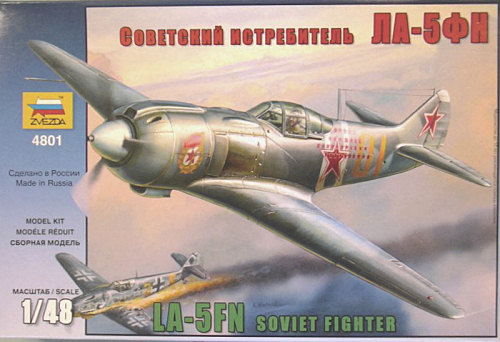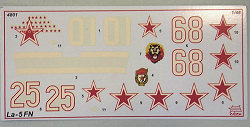
Zvezda 1/48 La-5FN
| KIT: | Zvezda 1/48 La-5FN |
| KIT #: | 4801 |
| PRICE: | 2400 yen at www.hlj.com ($24.95 msrp in US stores) |
| DECALS: | Three options |
| REVIEWER: | Tom Cleaver |
| NOTES: |

| HISTORY |
The Lavochkin radial‑engined fighters were the first Soviet fighter aircraft to at least be able to hold their own with the Fw‑190 at low to medium altitudes ‑ which was where most combat over the Eastern Front took place. Along with the Yakovlev series, the Lavochkins were the backbone of the Soviet fighter arm, with 9,920 La‑5s built between July 1942 and November 1944.
Design of the La‑5 series was difficult, inasmuch as it came from the inline‑powered LaGG‑3 and had to graft a 49.6‑inch diameter M‑82 radial to a fuselage designed to mount a 30.5‑inch wide Klimov M‑105 engine. That it was done at all was due to the fact that the 1,676 hp of the M‑82 was superior to the 1,100 hp M‑105; one of the main problems of the LaGG‑3 being the fact that it was underpowered.
With the additional power, the La‑5 could carry a considerably heavier armament than the under‑armed LaGG‑3. Rather than the two 50‑caliber machine guns of the LaGG‑3, the La‑5 carried two 20mm ShVAK cannons.
The La‑5FN (Forsirovanny Neprosredstvenno or "directly boosted) was powered by an 1,850 hp ASh‑82FN engine that developed 150 more horsepower than the ASh‑82F that powered earlier versions. It was the first of the series to equal theperformance of the Bf‑109G‑6, though it could only "hold its own" against the Fw‑190. It was particularly well‑suited to a close‑in, high‑g maneuvering style of combat.
The La‑5FN first saw combat during the Battle of Kursk in July 1943. It was a nasty surprise for the Luftwaffe. The 14La‑5FNs of the 32nd Guards Fighter Aviation Regiment took part in 25 aerial combats during July and August and claimed 33 Germanaircraft, including 21 Fw‑190s and 3 Bf‑109Gs.
In May, 1944, twenty highly experienced Czechoslovak Air Force pilots, who had been discharged from the RAF and transferred to the Soviet Union, began to form the nucleus of an independent Czech fighter regiment when they commenced training on La‑5FNs.
After 5 50‑minute flights in an La‑5UTI, they were deemed ready to solo in the La‑5FN. They saw combat after the Germans began taking over the territory of Slovakia on August 29, 1944. The Slovak Army resisted the Germans, and by October 1944 the insurgent army numbered 50,000 troops and 7,000 partisans. The are controlled by the insurgents was completely surround by German forces and was an isolated pocket deep in German‑held territory. The 1st Czech Fighter Regiment flew into Tri Duby airfield on September 21, 1944, with 21 fighters. The following day they entered combat when they attacked the Luftwaffe airfield at Piestany and destroyed 10 aircraft. Several other strafing attacks were conducted against German flying fields in the following days, which took the Germans completely by surprise.
By October 25, 1944, the Germans were closing in on Tri Duby, and the air support bridge from the Soviet Union and U.S. forces in Italy was ended. Eleven surviving La‑5FNs took off that evening in hopes of reaching Soviet‑controlled territory.
One was shot down over the Carpathians, though the pilot was rescued and joined the partisans. The ten other La‑5FNs managed to reach airstrips in liberated Hungary, Romania and the Ukraine. During a month of combat, the Czechs flew 573 sorties, destroying 13 German aircraft, as well as two tanks, three AAA positions, three locomotives and 77 trucks. Ten La‑5FNs were lost, with three pilots killed in action.
The wooden La‑5FN had not been built to last, and the aircraft quickly disappeared from the V‑VS within two years of the end of the war.
| THE KIT |
 The only other kits of the La-5FN produced in 1/48 is a very accurate vacuform
from Falcon and a very inaccurate injection-molded kit from Hobbycraft. I once
did an injection plastic La-5FN by grafting the good parts of the Hobbycraft kit
to the LaGG-3 kit released by Squadron, which still had more than a few
problems. You can read my review of the Falcon vacuform here in the archives.
The only other kits of the La-5FN produced in 1/48 is a very accurate vacuform
from Falcon and a very inaccurate injection-molded kit from Hobbycraft. I once
did an injection plastic La-5FN by grafting the good parts of the Hobbycraft kit
to the LaGG-3 kit released by Squadron, which still had more than a few
problems. You can read my review of the Falcon vacuform here in the archives.
Zvezda’s first 1/48 kit makes both of those kits completely obsolete. Indeed, the kit this can be most closely compared to is the Eduard Fw-190 series. (Editor's Note: I've shown one of the sprues as an example.)
The kit provides a complete interior - engine, accessories, gun bays, cockpit - that can be displayed either opened up or closed, with separate control surfaces that provide delicate surface detail. The cockpit canopy is clear and thin, and can be posed either open or closed. Wing trailing edges are thin, and all the moldings are sharp and crisp.
The
only negatives I see are that the engine cylinders are not molded with cooling
fins, and that the instrument panel is not as detailed as it should be. As far
as the engine is concerned, once all the exhaust ducting is added on, it wo uld
be difficult to see that cooling fins. With the instrument panel, one can forge
ahead with what is there or wait for Eduard to come up with a nice photo-etch
detail set. The kit lacks seatbelts, but these can be provided from Eduard’s
RAF seatbelt set.
uld
be difficult to see that cooling fins. With the instrument panel, one can forge
ahead with what is there or wait for Eduard to come up with a nice photo-etch
detail set. The kit lacks seatbelts, but these can be provided from Eduard’s
RAF seatbelt set.
Decals are printed with flat finish, and include markings for the well-known “01", though the camouflage finish in the instructions is incorrect (read my review of the Falcon kit to get the right markings). At least one of the markings on the sheet is for an La-5FN flown by the Czechs at Tri Duby during the Slovak National Uprising.
| CONCLUSIONS |
In the box, this looks to be the injection-molded La-5FN we have all been waiting for. The kit does not appear difficult, and test-fitting reveals it has the potential to be a show-stopper in the right hands. At a price of only 2,400 yen (around US$20) it is very good value indeed.
Thanks to HobbyLink Japan for the review copy.
If you would like your product reviewed fairly and quickly, please contact me or see other details in the Note to Contributors.